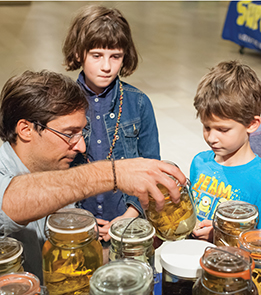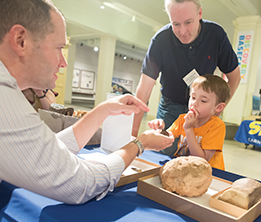 Winter 2014
Winter 2014|
Ask a Scientist
Curious visitors share their finds with museum scientists who help translate the wonders of the natural world. They walk into Carnegie Museum of Natural History by the dozens, lugging heavy rocks, cradling feather-light animal bones, and offering up photographs of mysterious insects.
“Keep collecting stuff. You’re doing great. When I was your age, I collected stuff, too. If you keep it up, you could become a paleontologist, too.”
- MATT LAMANNA, ASSISTANT CURATOR OF VERTEBRATE PALEONTOLOGYKollar identifies it as part of the fossilized stem of a crinoid, a marine animal that was once attached to the sea floor. He says that he, too, had visited the very same park, and estimates the age of the rock at about 400 million years old. “Wow! I’m shocked,” says Lutton, his eyes widening. “I thought it was about 10 years old!” And so it goes on “Super Science Saturday: Specimen Identification Day,” an afternoon filled with revelations large and small. The four-hour event on September 13 feels a little like the natural history equivalent of the Antiques Roadshow, except instead of people seeking appraisals and small fortunes for furniture, statues, and jewelry, visitors of all ages come craving the expertise of museum scientists in identifying bugs, bones, plants, shells, fossils, and, of course, rocks of all shapes and sizes. Rose Mizerak arrives in a safari hat with field goggles glued to the front. She doesn’t just look like a naturalist, she acts the part, too, as she whips out her smartphone to reveal a photograph of an insect that had recently landed on her doorbell. “I had never seen a bug with clear wings before,” she says, as she shows her phone to John Rawlins, the museum’s longtime curator of invertebrate zoology. Rawlins identified the insect as an Anthrax fly, and after consulting with Chen Young, associate curator emeritus of invertebrate zoology, further clarified that Anthrax is a genus of flies in the taxonomic family Bombyliidae. Despite the ominous-sounding name, it’s a friend to man, Rawlins notes. “If you would watch bombyliids [hover flies] in the middle of the day, you would see them fly over a pile of wood, and they would flip their abdomens like little bombers. The maggots of Anthrax feed on the bad bugs—the carpenter bees that eat your house. So this is a good bug.” Even after Mizerak walks away from the table, Rawlins flips through a field guide. Then he walks across the crowded room to show her an image. “There’s your bug,” he says. She beams. “She’s in bug heaven,” remarks her husband, Tim. After all, it’s not every day the public can pick the brain of a renowned expert like Rawlins for his encyclopedic knowledge of insects. Also on hand are museum scientists and collection managers who specialize in mammals, botany, birds, reptiles and amphibians, gems and minerals, anthropology, vertebrate paleontology, and mollusks. “I’m really interested in entomology,” says Mizerak. “Dr. Rawlins was very helpful. On the Internet, it’s not always easy to find the exact species.” Kevin and Cindy Schmidt of Waterford, Pennsylvania, haul in a box of rocks, including a large flat one with trace fossils on either side, which they found on a neighbor’s farm. The couple, so enamored by their find that they’ve been displaying it on their fireplace, traveled more than two hours to the museum with their two children, 9-year-old Samantha and 4-year-old Jared. Kollar takes a close look at their treasure and explains: “It’s Late Devonian age, probably 360 million years old,” he says. “I can tell it’s siltstone because when you scrape it with your fingernail or teeth there is a little grit to it. This type of rock is formed in an ancient delta. There are trace fossils in the rock formed by some unknown invertebrate that was burrowing through the soft sediment searching for food.” Samantha marvels at the age of the rock. “It’s older than dirt!” proclaims her mother, Cindy. “It’s a rock found right where we live. We take it for granted.” At the nearby vertebrate paleontology station, Trent Hicinbothem, 6, and his brother Jude, 4, have brought plastic bags filled with specimens culled from Allegheny National Forest. “They’ve been counting down this day for a month,” says their mother, Ellen Hicinbothem, of New Kensington. She encourages the boys, whom she homeschools, to write scientific questions on an index card to help them identify the specimens. “Is it a bone? If so, what kind?” writes Trent. He consults with Matt Lamanna, assistant curator of vertebrate paleontology. “I think it’s a rib from a fish,” Trent confides. Lamanna, a paleontologist who has discovered dinosaurs in Egypt, Argentine Patagonia, China, and Antarctica, among other places, helps identify the mystery bones. Perhaps more importantly, he offers up some words of encouragement to kids handing him their boxes filled with rocks and bones, carefully sorted by size. “Keep collecting stuff. You’re doing great,” he tells the young collectors. “When I was your age, I collected stuff, too. If you keep it up, you could become a paleontologist, too.” At the very least, they could grow up to have a lifelong interest in the natural world, like Verna and Bernie McGinty. The couple, both 65 years old and residents of nearby Mt. Lebanon, have brought in a bone they found during a walk in Boyce Mayview Park in Upper St. Clair. They show it to John Wible, curator of mammals, who says it’s a toe bone, possibly of a cow or horse. Wible snaps a photograph of the bone. Two days later, after looking through the museum’s collection, he would contact the pair with a confirmation: It is indeed a toe bone from a horse. “It’s neat that we found it just sticking up out of the hillside,” Bernie says. Wible’s follow up has further sparked Verna’s determination to keep her eyes open while she walks. “It’s like nature is putting on a big show.”
|
Changing the Equation · To Have and to Hold · Art Responding to Life · Living Large · President's Note · NewsWorthy · Face Time: Tim Pearce · Artistic License: An American Treasure in the Making · Science & Nature: Painting the Parade of Life · Travel Log · The Big Picture
 |
Copyright © 2017 CARNEGIE Magazine. All rights reserved. |



